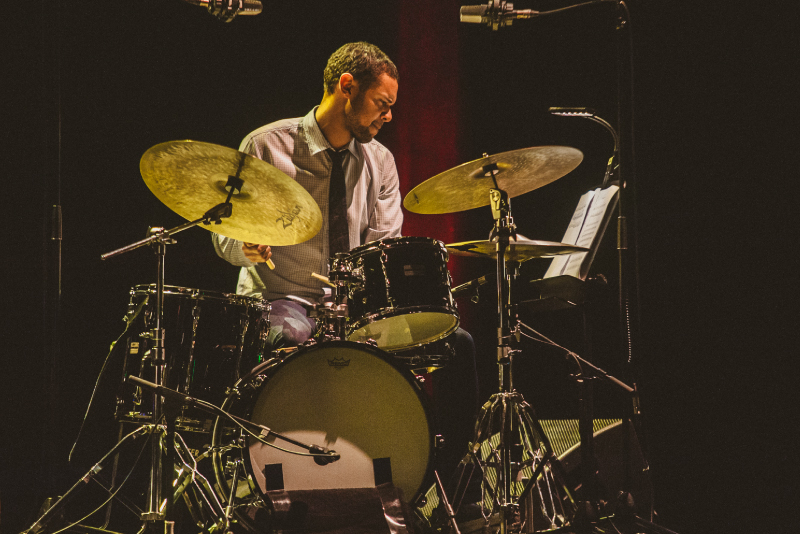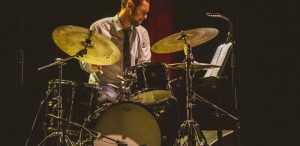
Myele Manzanza discusses his musical lineage and collaborative streak
Few burgeoning drummers can match the artistic communication achieved by Myele Manzanza. An accomplished musician who dabbles in production; he assimilated the principals of percussion from his father, an accomplished African musician, absorbing further knowledge by way of several high profile collaborations, on the way to becoming the versatile solo artist he is today. As part of Theo Parrish’s live outfit, The Unit, he explored the nuances of Parrish’s programming and with L.A.-based MC’s and musicians, discovered the hip-hop swagger that underpins his musical style. His music is far more than a vehicle for his drumming, leading the listener through the familiarities of modal jazz to far reaches of electronic fusion, referencing the various stages of Myele’s artistic development.
Ahead of his show at Band on the Wall next week, we spoke to Myele about his musical lineage, the music of Bobby Hutcherson and his collaborative desires.
You’ve roots in New Zealand and Congolese lineage, but you’ve also worked in musical hubs like Berlin and Los Angeles, since establishing yourselves as a solo artist. Have your excursions and your musical heritage significantly influenced the music you’re making today?
‘Absolutely. On the heritage side – having my father and his musical influence around me as a child definitely gave me a strong grip of African rhythm, which has given me a strong foundation in all the music I do. As far as the excursions go, while New Zealand is where I’m from I definitely feel like an international citizen both musically and culturally, so big cultural melting pots like Berlin and LA feel like home to me too. Also, cities like that tend to attract people who are open to new ideas and offer concentrated places to draw from a wide range of influences, so a lot of new movements tend to come out of environments like that. While there’s something in having access to cities like that, being from somewhere as isolated as NZ gives me an outsiders perspective which has its own unique viewpoint too. While we don’t the depth of tradition in jazz, classical, hip-hop, pop that some of those other places have, it means I’m not beholden to any of those traditions either. If I want to bring free-improvised music together with Detroit techno, or use classical harmony and arrangements with samba, Dilla style beats or trap music then there’s no schools of thought or traditions with enough power in New Zealand to say “that’s not how it’s done”.’
Your father, Sam Manzanza, is an accomplished percussionist who has been influential in popularising African music in New Zealand. Is it a unique experience to perform with your father and what are the key things you’ve learned from him?
‘It was unique in the sense that my childhood had music as just another activity that I could participate in, much like I imagine kids in the UK just have football or cricket as a fun activity to do in the neighbourhood. I could tag in on tours with him or African drum classes that he ran without it being a disciplined obligation, so when I realised I wanted to start taking music seriously I already had a natural foundation that was there organically.’
Tony Allen took on some Art Blakey compositions during his recent show at Band on the Wall. You’ll be doing something similar, tackling material by Bobby Hutcherson, alongside your own work from various projects. Can you tell us about first encountering Hutcherson’s work and how his compositions of his have lent themselves to your own interpretation?
‘I first came across Bobby Hutcherson’s music from a Madlib track that sampled Montara. I always thought that was dope but I was playing a random trio gig in Wellington where the guitarist called it and I didn’t realise until then how good a composition it was. To me, Montara feels like one of those inspired compositions where everything makes absolute sense. Like the music was telling Bobby what to do when he wrote that one. The space in it gives a lot of room for expression and re-interpretation and finding your own thing within it so it’s one of my favourites to pull out at shows.’
Have you experienced turning points during your artistic development, moments or occurrences that have significantly influenced how you approach music today?
‘Many. Red Bull Music Academy in 2010 was a big one. At that time I was a pretty competent musician but I was trying to be an expert chameleon who could adapt to any situation and be a great emulator, whereas most of the other participants had already started to define their own sound which was something I hadn’t really been thinking about until then. Musicians like Imon Starr, Jonathan Crayford, Theo Parrish, Ross McHenry, Mark de Clive-Lowe and several other mentor figures over the years have helped shape my own development too.’
How did the gig with Theo Parrish come to be? Was it a daunting prospect to be interpreting programmed drums and how much artistic license were you afforded in doing so; did Theo have a vision for how the live arrangements would sound or was he keen to hear your ideas?
‘The Theo gig came about after he heard a jazz trio version I did of his track Love Is War For Miles. He was in need of a drummer for that tour and I guess he knew I’d have an understanding of his rhythmic sensibilities and how to interpret that live. He definitely has a strong sense of himself and his musical ideas so there was a fair amount for me to adapt to as far as the subtleties of how he’d put his drum patterns together on MPC and the ways of interpreting that on the drums. Things like holding a pattern on snare and hi-hat then fading the kick drum in slowly, the nuances quantized-yet-human feel he gets out of his beats and the way dancers respond to that…
There definitely was some artistic license and as a band we collectively worked to translate some of the idiosyncrasies of his productions to the live setting, which meant sometimes where the original production was a fairly static loop we’d let it organically open up into new territory that only that group of musicians could take it too.
He released a live recording from that tour called Walkin Through The Sky (I think it might have even been from the Manchester concert), and if you compare that to the original there’s definitely a lot more live energy and I’m taking liberties on the drums as the energy builds up. At the same time though he’d always know when to rein us in and keep it locked too. All in all, he was a great bandleader with a strong vision to work for.’
The City of Atlantis video with Quartetto Fantastico, Charlie K and Nia Andrews is truly amazing piece of work. Given the international focus on the West Coast a present, do you see a future working with the artists involved in that scene, or are you looking further afield?
‘I think with the current movement of musicians coming out of California right now there are definitely parallels with what I do and what they do because we’d have a lot of the same influences. Coltrane, Wayne Shorter, Fela, Dilla etc. We come from the same musical bloodline even if I’m all the way over in New Zealand.
I hope to be able to collaborate with more of those guys in future but at the same time, there’s a lot of heavyweights emerging from all over the world too. I’ve been a big fan of the UK Broken Beat thing for years and that seems to be on the precipice of a re-emergence, which I’m excited to see. The Melbourne scene over the last 5 years has been doing some amazing things with artists like Hiatus Kaiyote, Remi and others starting to emerge with a thing all of their own.
While the Internet has definitely caused issues as far as the financial devaluation of music, it’s also democratized it and taken away the power of the traditional gatekeepers, so we’re seeing a wealth of new music emerging from all over the world and that’s created a wider transmission of ideas for artists to draw from. From my home in New Zealand I can watch YouTube clips of some amazing young drummer I’ve never heard of at a dive bar in New York and get access to a whole range of musical language to draw from and influence my music, so with those borders being broken down it means collaborations like the City of Atlantis video and others are that much easier to make happen creatively.’
What’s on the horizon for you, musically or otherwise?
‘After this UK/EU tour, I’m going straight into development of a show with the Australian contemporary dance company KAGE called Out of Earshot that we’re premiering at the Melbourne International Jazz Festival. Just me on acoustic drums and 4 dancers. The concept is loosely centred around one of the dancers Anna Seymour who was born deaf (the closest she gets to a sense of hearing is feeling the vibration of low frequencies. Anything above the kick drum is out of range). We’re kind of playing with the idea of what it’s like to be deaf, contrasts between sound and silence, how sound can be beautiful or weaponised and a bunch of other semi-abstract ideas around that.
It’s pretty exciting for me as I’m learning a lot about how dancers work and I’m quite physically involved as well as musically. Getting picked up, climbed on and spun around etc. Also, as it’s just drums it means that I’m hyper exposed throughout the whole show so it’s forcing me to be way more attentive to my sound and dynamics as well as the physical way I move around the kit which has helped focus my drumming a great deal.’







